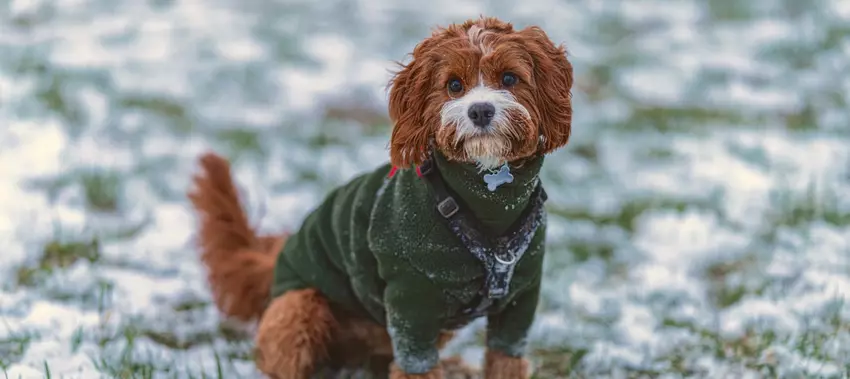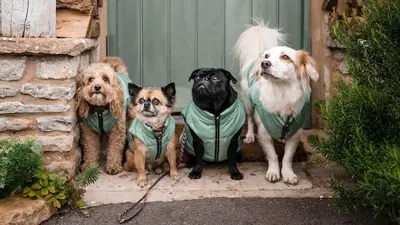How to Prepare Your Dog for Winter
- 14 Nov 2024
- 7m read

While we’re piling on the layers and snuggling under blankets, our pups may also need a little extra care to stay safe and warm. Here’s how to help your furry family member thrive this winter.
Do Dogs Sleep More in Winter?
Yes, dogs do tend to sleep a bit more in the winter months.
Just like humans, dogs can feel a little more sluggish when it’s cold outside. Shorter days and longer nights can act as a signal to their bodies that it’s time to wind down. The cooler weather and dim light can also affect their natural rhythms, but it’s perfectly normal for them to snooze more often during winter.
However, if the extra sleep is accompanied by other strange symptoms, such as reluctance to go for walks or not eating properly, schedule a check-up with your vet to make sure that everything is okay.
How to Keep Your Dog Warm in Winter
There are lots of things you can do to keep your dog warm throughout the winter, including:
Keep their bedding warm and cosy
Your pup’s bed is their sanctuary, so make sure it’s winter-ready. Place their bed in a warm spot away from any drafts or cold tile floors. You could even layer it with some blankes for extra warmth. If you have a senior dog, consider a heated dog bed or pad, which can help relieve stiff joints during colder months.
Feed them well
Keeping warm requires lots of energy. Dogs may need a little extra fuel in the winter. Talk to your vet about adjusting their food if needed, and make sure they have fresh water to stay hydrated, as central heating can be dehydrating.
If you currently feed your dog Butternut Box (lucky them) you can easily make adjustments to your plan size from within your account.
Keep them dry
Wet fur makes dogs colder faster, so if your dog gets damp in the rain or snow, towel them off thoroughly when you get home. Drying their coat and paws after a walk helps them warm up faster and prevents chills.
What Temperature is Too Cold to Walk a Dog?
Every dog’s tolerance for cold is different, but as a general guideline, you’ll want to pay attention when temperatures dip below 7°C (45°F).
For smaller or thinner-coated dogs, you may want to shorten walks below this temperature. For those very chilly days, typically under -1°C (30°F), even larger, thicker-coated dogs may benefit from shorter, more frequent outings.
If your dog is shivering, lifting their paws frequently, or trying to head back home, it’s a good sign they’re ready to wrap things up. Remember, safety and comfort come first, so if it’s too cold for you, it might be too cold for your furry friend, too.
Walking Your Dog in the Dark
With daylight hours slipping away, walking your dog in the dark can feel unavoidable.
To ensure both you and your dog are visible to others, consider using reflective leads, collars, and harnesses. These bright, reflective materials make you stand out even in low-light conditions.
For added visibility, light-up collars, clip-on lights, or even glow-in-the-dark tags are a great way to make sure drivers, cyclists, or other walkers can spot you both from a distance.
If you find yourself walking through quiet lanes or unfamiliar paths, it’s essential to carry a torch or headlamp. A headlamp is especially useful as it keeps your hands free and helps illuminate both your way and your dog’s path, preventing accidents or injuries.
And don't forget to keep your dog on a lead, particularly in poorly lit or less familiar areas. At night, it’s harder for drivers and other people to spot you, so having your pup securely on a lead ensures they stay close and safe.
By investing in the right gear and staying vigilant, you and your dog can enjoy peaceful, safe walks together, no matter how dark it gets.
Walking Your Dog in the Snow
Sadly, a white Christmas is no longer a guarantee, we’re far more likely to see snowfall appear in January or February. Snowy walks can be magical for you and your pup, but wintery conditions bring a few extra risks to be aware of. Here’s how to keep your dog safe and happy on those snow-filled adventures.
Stay away from frozen lakes and rivers
Even if the ice looks solid, frozen lakes and rivers can be dangerous for curious pups. Thin ice can easily crack under their weight, leading to potentially life-threatening situations. It’s best to keep your dog on a lead near frozen bodies of water to be on the safe side.
Be wary of rock salt and antifreeze
Salt and antifreeze are common hazards during winter walks. Rock salt on pavements can irritate your dog’s paws and, if ingested, can upset their stomach. Antifreeze, with its sweet smell and taste, can be toxic to dogs. Try to steer clear of areas where these are visible, and consider dog booties for extra protection.
Bathe or wipe down your dog after walks
After each snowy outing, give your dog’s paws a quick wipe down to remove any salt, chemicals, or dirt. A warm, damp cloth can do the trick, and a gentle rinse of their paws is ideal to prevent any irritation. This small step will help protect your dog’s skin and coat from the harsh winter elements.
Watch out for frostbite and hypothermia
Dogs can be surprisingly tough in chilly weather, but frostbite and hypothermia are still real risks, especially for dogs with short coats, smaller breeds, puppies, and seniors.
Frostbite often affects areas like the ears, tail, and paws, where fur is thin and skin is exposed. Hypothermia can set in quickly if they’re out for too long in extreme cold, so look out for shivering, weakness, or signs of confusion.
Dog Walk Alternatives
If the weather outside is frightful, fear not, because staying indoors can be delightful. Try out these dog-friendly indoor activities:
Interactive toys: Puzzle toys or treat-dispensing balls can keep their minds sharp and their paws busy.
Tug-of-war: A good game of tug-of-war indoors can be just as satisfying as a walk.
Hide and seek: Hide treats around the house and encourage your dog to find them.
Mixing these activities with regular walks will keep your dog’s spirits high, even when the weather isn’t quite right for long outdoor adventures.
Winter Accessories for Your Dog
Winter is the time to break out the fancy gear. Not only does it make your pooch look ultra-stylish, but the right accessories will help protect them from the chill.
Reflective harnesses and leads: Perfect for visibility in the early evenings and dark mornings.
Waterproof booties: Booties can help keep their paws dry and free from harmful salts and chemicals.
Snug dog sweaters and jackets: Some dogs love the extra warmth layers bring, especially if they have short fur.
With the right winter wardrobe, your dog will be ready for anything, come rain, snow, or frosty mornings.
Does My Dog Need a Winter Coat?
Not all dogs need a winter coat, but many with short coats, smaller sizes, or lower body fat—like Chihuahuas, Greyhounds, Dachshunds, and senior dogs—benefit from the extra warmth.
In contrast, breeds with thick, double-layered coats, such as Huskies, Newfoundlands, and Bernese Mountain Dogs, are naturally built for colder weather and usually stay warm without additional insulation.
Choosing the Right Winter Coat
If your dog falls into the "needs a coat" category, be sure to choose one that fits well.
The coat should cover their back and abdomen, leaving room for free movement and avoiding any tight areas around their neck, shoulders, or legs. Look for materials that repel water and provide wind protection for those gusty days. Opt for adjustable straps and soft linings to keep your pooch comfortable and cozy.
The Importance of Sticking to a Routine
It’s easy to hibernate when it’s cold, but keeping a routine helps maintain your dog’s mental and physical health. Regular mealtimes, consistent walks, and scheduled play sessions can help your pooch stay on track and keep any winter blues at bay.




